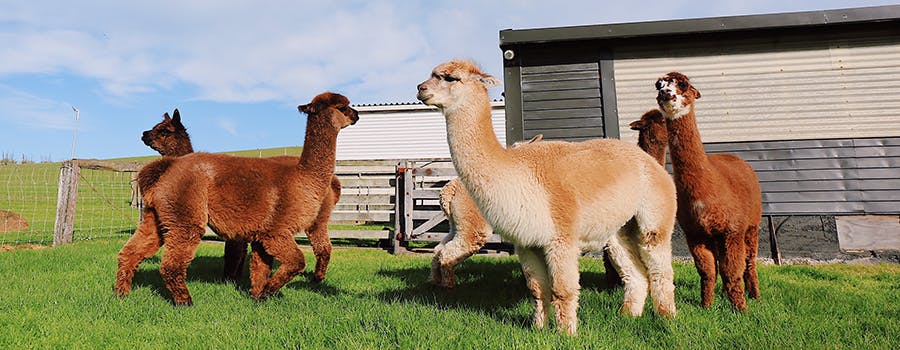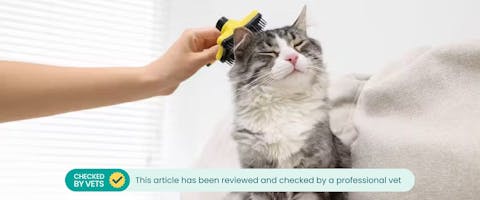Updated 14/06/2024
“Cough, cough, yuck!” While seemingly unpleasant for your poor kitty, hairballs are a natural part of a cat’s life and result from their purr-fect grooming habits. Cats are meticulous groomers, spending a significant amount of time each day licking their beautiful fur coats. The hair ingested forms these (kinda gross) hair clumps – you know, the ones that usually end up on your carpet every few months.
So, if you notice your cat throwing up a hairball, it’s usually nothing to worry about. However, it's important for pet parents to understand the reasons behind hairballs and their potential impact on cat health, and to take steps to reduce the amount of hairballs their fluff monster produces.
Trending posts
Purr-use some of the top blogs our members have been loving this month- Top male dog names for your new furry friendGot a new furry family member in your pack? Check…

- Top female dog names for your new fluffy palWelcoming a new pooch into your family? Explore…

- 250+ gray cat names your silver feline will loveRecently welcomed a fluffy gray bundle of joy into…

- What are normal pet sitting rates?Discover the average pet sitting rates for animals…

- Unique dog names to stand out from the packDare to be different with our list of the best…

What causes hairballs in cats?
When cats groom themselves (or others), their tongues, with tiny hook-like structures, catch loose hair. While grooming is essential for maintaining a clean and healthy coat, it inevitably results in the ingestion of some hair. Most hairs pass through the digestive system, but some can accumulate in the stomach forming hairballs.
While it is normal for cats to throw up the occasional hairball, increased hairball formation can be influenced by various factors, including:
The type of breed: long-haired vs. short-haired cats
Ragdolls, Persians and Maine Coons, or any other long-haired breeds, are more prone to hairball formation. Their long, dense locks make it easier for loose hairs to become trapped during grooming and lead to larger and more frequent hairballs.
On the other paw, while short-haired breeds like the American Shorthair or Siamese aren’t immune to hairballs, they typically experience them less frequently. Their shorter hair means it’s less likely to accumulate in the stomach, reducing the risk of hairball formation.
Excessive grooming due to skin diseases, stress, or boredom
Conditions such as dermatitis or allergies can cause itching, prompting your cat to groom themselves excessively. This increased grooming can result in more hair ingestion, leading to larger and more problematic hairballs.
Cats may also start excessively grooming as a response to stress, anxiety, or boredom. This can lead to psychogenic alopecia and, the more your cat licks themself, the more fur will be ingested resulting in hairballs.
Digestive disorders
Cats with gastrointestinal issues may experience a slower transit of fur through the digestive system. This delay can contribute to the accumulation of hair in the stomach, increasing the likelihood of hairball formation.
Recommended reading: 10 best cat food for cats with a sensitive stomach
Recognizing the signs of hairballs in cats
“What do hairballs in cats look like?” you may ask. Hairballs are hairy, mucus-y masses that are typically tubular in shape (despite their name, they’re more of a sausage shape than a ball). They may be brown or green with flecks of color from your cat’s hair.
Cat hairball symptoms include your cat gagging, coughing, or making hacking sounds as they try to expel a hairball.
When to be concerned
It’s important to keep an eye on your hairball-producing kitty and take them to the vet if they’re experiencing any more worrying signs related to a hairball, including:
- Frequent hairballs: occasional hairballs are normal (about once per month), but if your cat is getting hairballs frequently or persistently, it may indicate an underlying problem.
- A change in behavior: any noticeable changes in your cat's behavior, such as lethargy, reduced appetite, or hiding, may be a cause for concern.
- Over-grooming: excessive grooming leads to the ingestion of large amounts of hair, increasing the risk of hairball formation.
- Signs of discomfort: if your cat shows signs of discomfort, such as abdominal pain or difficulty passing stools, it may indicate an underlying gastrointestinal issue.
Cat hairballs and vomiting: understanding the difference
It can sometimes be confusing whether your cat’s hacking noises are just a hairball or vomiting. Understanding the difference will help you to know how to react:
- Appearance: hairballs are typically tubular masses of hair, often with a mucus-like coating. Vomit, on the other hand, is usually liquid and may contain partially digested food.
- Frequency: hairballs are occasionally expelled, whereas vomiting due to other issues may be more frequent and accompanied by additional symptoms.
- Behavioral cues: cats may be less distressed during a hairball episode compared to vomiting. If your cat seems otherwise healthy and resumes normal activities after expelling their hairball, it's likely to be just part of their quirky routine.
If you have concerns about your cat's health or notice persistent issues, we recommend that you consult with a veterinarian as soon as possible.
Reducing hairballs
While you can’t prevent hairballs in cats, there are steps you can take to reduce the amount of hairballs they produce. Here are some best practices to help you minimize these hairball cat-astrophes to keep your kitty happy and healthy.
Regular grooming
Regular brushing helps to remove loose fur before it’s ingested during grooming. For long-haired breeds, daily brushing may be necessary, while short-haired cats may benefit from brushing a few times a week.
Use cat special grooming tools to effectively remove loose hair and pay extra attention to areas prone to matting, such as around the collar, around the elbows, and between the legs.
Dietary solutions and supplements
You can easily find specialized hairball cat food and treats formulated for hairball control in your local supermarket or pet shop. These often contain increased fiber to aid in the passage of hair through the digestive tract. Also, take extra care to make sure your cat with hairball issues is well hydrated as this can aid overall digestive health.
If your cat’s hairballs are a regular occurrence but are deemed safe by your vet, consult with them to find a suitable diet for your kitty's needs. They may suggest adding fiber supplements or specialist cat food for hairballs to your cat's diet.
Environmental and behavioral strategies
As we know, stress can be a contributing factor to your cat’s frequent hairball production. Identify and address sources of stress in your cat's environment and provide safe spaces, hiding spots, and elevated platforms.
If your cat’s hairballs are a result of boredom-related grooming, keep your cat mentally stimulated and physically active with interactive toys, scratching posts, and climbing structures.
Regular veterinary check-ups
It’s important to schedule regular veterinary check-ups to monitor your cat's overall health. Addressing potential health issues promptly can help to reduce hairballs in cats.
Cat hairball treatment options
If your cat is only passing the occasional hairball, there’s no real need to take action, as it’s a normal part of feline life. However, if you are worried about your cat’s hairballs we strongly advise you to seek a vet’s help as soon as possible.
When to see a veterinarian
You should take your cat to the vet immediately if they are displaying worrying symptoms such as:
- If your cat is consistently producing large or frequent hairballs
- If there are signs of distress, lethargy, or loss of appetite
- If your cat is retching or vomiting without expelling hairballs
- If you notice changes in litter box habits, such as straining to defecate or producing small, hard stools
- Signs of dehydration, such as dry gums or lethargy
- Abdominal discomfort or bloating
- Weight loss
In severe cases where hairballs lead to gastrointestinal obstructions, surgery may be necessary to remove the blockage.
Over-the-counter treatments and natural cat hairball remedies
If your cat is suffering from fairly frequent hairballs but your vet has confirmed there are no serious causes behind it, they may recommend over-the-counter cat hairball treatment such as pet-safe laxatives and lubricants. You may also be advised to treat your poor kitty with natural solutions such as cat grass or making sure your cat is well hydrated.
For more information on cat hairball remedies, take a look at our article: Cough up! How to find the pur-fect cat hairball remedy.
What to avoid
Before trying any medicine or home remedy, consult with your veterinarian to ensure it’s safe and appropriate for your cat. Also, make sure you don’t excessively use products like laxatives or lubricants as it may lead to nutritional imbalances.
If hairball issues persist, it's crucial not to ignore the issue. Chronic problems may indicate underlying health issues that require professional attention. Always consult with your veterinarian for guidance tailored to your cat's specific needs and to rule out any potential health concerns.
The long-term health implications of hairballs
If your cat is expelling them frequently, hairballs can pose long-term health implications if left untreated. The most common is gastrointestinal obstruction where hair accumulates in the stomach and can cause side effects such as vomiting, loss of appetite, and abdominal pain. This can become a serious and potentially life-threatening condition requiring surgical intervention.
This can be avoided by taking your cat to the vet if you notice your cat is frequently coughing up hairballs or if it accompanies any other worrying symptoms. Make sure to also schedule in regular veterinary check-ups to monitor your cat's overall health and inform your vet about any changes in your cat's behavior, grooming habits, or signs of digestive issues.
Meet our veterinary expert, Corinne
This article has been checked by veterinarian Corinne Wigfall BVMBVS(Hons) BVMedSci(Hons). Corinne is originally from Wales and moved to New Zealand after graduating university. She started her career with a university based equine internship and moved onto mixed and small animal practice. Currently she splits her time between online tele triage and working in an after hours vet clinic.
Hairballs in cats are a natural side effect of their grooming habits that lead to their meow-velous glossy fur. There is no cure for hairballs in cats but there are steps you can take as a pet parent or cat sitter to reduce the amount of hairballs in your paw-sitively charming pal.
Worried about a cat you are pet sitting but are unsure if a vet check-up is needed? TrustedHousesitters members gain access to our 24/7 Vet Advice Line where they can chat with our trusted team about any concerning issues.
Cat hairballs FAQs
Does drinking water help a cat pass a hairball?
Yes, adequate water intake can be a great hairball remedy for cats. Water plays a crucial role in maintaining hydration and supporting the digestive system. When a cat drinks enough water, it helps lubricate the digestive tract, making it easier for hairballs to move through the stomach and intestines.
Does butter help a cat pass a hairball?
We do not recommend giving your cat with a hairball issue butter to help the hair pass. Butter is high in fat and can lead to vomiting, diarrhea, and other health issues such as obesity if given in excess. Seek the advice of your veterinarian for safer alternatives made specifically for cats, such as pet-safe laxatives and lubricants.
What if my cat throws up hairballs every day?
If your cat is consistently throwing up hairballs every day, we strongly recommend that you speak to a vet as soon as possible. Daily occurrences could indicate an underlying issue that needs to be addressed.
Can cats poop out hairballs?
Cats generally don’t pass hairballs through their feces per se, but the digestive system does move most ingested hair through the gastrointestinal tract, so you might sometimes notice a small amount of hair in your kitty’s stool. However, the primary exit for a hairball (referring to the mass build-up of hair) is through regurgitation, not defecation.
What happens if a cat can't cough up a hairball?
If you notice your cat trying to cough up a hairball but can't, it can lead to potential complications, including gastrointestinal obstruction. Some cat hairball blockage symptoms include vomiting, discomfort and pain, and a reduced appetite.
If you suspect that your cat is having difficulty passing a hairball, or if you notice signs of distress such as persistent retching, coughing, lethargy, or changes in behavior, it’s crucial to seek veterinary attention promptly.
A veterinarian can conduct a physical examination, possibly perform diagnostic tests such as x-rays or ultrasounds, and recommend appropriate hairball treatment for cats. Treatment options may include cat hairball medication, dietary changes, or, in severe cases, surgical intervention to remove the obstruction.
How do you clean cat hairballs from vomiting?
To clean up cat hairballs, firstly, use paper towels to carefully lift and remove as much of the hairball as possible. Then, mix a pet-safe cleaning solution with warm water. Dampen a clean cloth or sponge in the solution, and gently blot the stained area. Avoid using harsh chemicals that could be harmful to your cat. Repeat the blotting process until the stain is lifted.
How do I know if my cat is choking or coughing up a hairball?
Distinguishing between a cat choking and coughing up a hairball can be challenging, as the symptoms may appear similar. However, subtle differences you can observe are: silent struggling (if your cat is choking, they may not always make coughing or retching sounds), pawing at the mouth, difficulty breathing, distress, and (in severe cases) a blue tongue or gums.
Does wet food help with hairballs?
Yes, wet cat food can contribute to reducing the frequency of hairballs due to its increased dietary fiber and moisture content.
Are hairballs painful for cats?
Hairballs themselves are generally not painful for cats. The discomfort associated with hairballs usually comes from the process of regurgitating the cat hairball vomit. When a cat is about to expel a hairball, you may observe behaviors such as coughing, retching, or gagging. While these actions can be uncomfortable for the cat, the hairball's passage itself is not typically painful.
Do cats feel sick when they have a hairball?
Cats may experience discomfort or a mildly upset stomach when they’re about to regurgitate a hairball, but it's not accurate to say they feel sick in the same way we humans do. The sensation leading up to hairball expulsion is more likely to be characterized by discomfort rather than true illness.
What if my cat is gagging but no hairball?
If you notice your cat coughing but no hairball is being produced, it could be that they’re experiencing hairball complications. Or it could be that they’re experiencing non-hairball-related issues such as digestive problems, foreign object or toxic ingestion, respiratory issues, or dental problems.
If you see your cat gagging consistently, showing signs of distress, or other concerning symptoms, it's crucial to consult with a vet right away.

